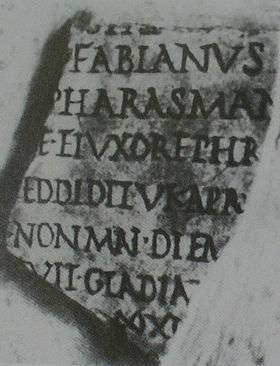Fasti Ostienses

A fragment of the Fasti Ostienses that mentions Pharasmanes II of Iberia
The Fasti Ostienses is a fragmentary marble calendar (fasti) from Ostia dating from 49 BC to 175 AD. Ostia was a harbor town at the mouth of the Tiber, with ties to Rome extending into the legendary past. The most likely public space for displaying the Fasti Ostienses was the Temple of Vulcanus, the chief god of the town. Many of the events recorded are religious. For each year, the consuls are listed, followed by key events of national importance, then the local duoviri and sometimes local events.
The marble slabs on which the fasti was inscribed were dismantled and used for other purposes, perhaps in late antiquity under Christian rule, or even earlier, during the Severan dynasty.
References
- Christer Bruun, "Civic Rituals in Imperial Ostia," in Ritual Dynamics and Religious Change in the Roman Empire. Proceedings of the Eighth Workshop of the International Network Impact of Empire (Heidelberg, July 5–7, 2007) (Brill, 2009), pp. 134–135.
Edition
- Ladislav Vidman, Fasti Ostienses: edendos, illustrandos, restituendos (Československá Akademie, 1982).
This article is issued from Wikipedia - version of the 10/28/2016. The text is available under the Creative Commons Attribution/Share Alike but additional terms may apply for the media files.